Errata (July 16 2023) Since the original publication, I’ve made substantial improvements to the data in the post. The full account of changes are detailed in this post. The total funding tracked in the data increased to $290M (from $245M) and the main updates are:
|
This post is part of EA Strategy Fortnight. You can see other Strategy Fortnight posts here.
I’ve been reflecting on the role of funding in the EA movement & community over time. Specifically I wanted to improve common knowledge around funding flows in the EA movement building space. It seems that many people may not be aware of it.
Funders (and the main organizations they have supported) have shaped the EA community in many ways - the rate & speed at which EA has grown (example), the people that are attracted and given access to opportunities, and the culture and norms the community embodies and the overall ecosystem.
I share some preliminary results from research I’ve conducted looking at the historical flow of data to movement building sources. I wanted to share what I have so far for the strategy fortnight to get conversation started. I think there is enough information here to understand the general pattern of funding flows. If you want to play around with the data, here is my (raw, messy) spreadsheet.
Changelog:
- July 16 2023 - I made substantial changes to the data, which are cataloged in a new post (to be posted soon)
- June 24 2023 - Added in 2012 donations from Jeff & Julia and updated relevant graphs & tables
- June 25 2o23 - After a conversation with a donor, I realised I have significantly undercounted the number of individual donors (especially in the earlier years) and have changed the estimates of "other donors" in the relevant sections. Donation data from 2012-2016 is likely off by an order of magnitude during this period.
Key observations
Overall picture
Data for 2023 is year-to-date as of June 17 2023.
Total funding 2012-2023 by known sources
According to known funding sources, ~$290M have been granted to EA movement building efforts since 2012. I estimate the real number is between $300-400M.
The Open Philanthropy EA Community Growth (Longtermism) team (OP LT) has directed ~55% ($159M) of known movement building funding (incl. ~4.1% or $12M to the EAIF) since 2016. Note that OP launched an EA Community Growth program for Global Health and Wellbeing in 2022, which started making grants in 2023. Their budget is significantly smaller (currently ~$10M per year) and they currently prioritize effective giving organizations.
The unlabeled dark blue segment is “other donors”
Funders of EA Groups from 2015-2022
This text of this section has not been changed since the original publication. The chart has been updated to allow for consistent color-coding.
See discussion below for description of the "CEA - imputed" category. Note that I’ve primarily estimated paid organizer time, not general groups expenses.
EA groups are an important movement building project. The Centre for Effective Altruism (CEA) has had an outsized influence on EA groups for much of the history of the EA movement. Until May 2021, CEA was the primary funder of part- and full-time work on EA groups. In May 2021, CEA narrowed its scope to certain university & city/national groups, and the EA Infrastructure Fund (EAIF) started making grants to non-target groups. In 2022, OP LT took over most university groups funding from both CEA (in April) and EAIF (in August). Until 2021 most of CEA’s funding has come from OP LT, so its EA groups funding can be seen as an OP LT regrant.
Breakdown of funding by source and time (known sources)
2012-2016
Data in this section has been significantly changed from the original.
Before 2016, there was very limited funding available for meta projects and almost no support from institutional funders. Most organizations active during this period were funded by individual earning-to-givers and major donors or volunteer-run, not all of which is captured in the numbers. Here’s a view of funding from 2012-2016:
No donations from Jaan Tallinn during this period were via SFF as it didn’t exist yet. There is a $10K donation from OP to a UC Berkeley group in 2015 that is not visible in the main chart. “Other donors” includes mostly individual donors and some small foundations. OP Other includes grants from Good Ventures (before OP was founded, hence the OP - Other categorization) to GiveWell (discounted by 30%).
Quick details on active funders during this period:
- Individual Donors: A number of (U)HNW & earning-to-give donors, many of whom are still active today, such as Jaan Tallinn, Luke Ding, Matt Wage and Jeff Kaufman & Julia Wise. Donation data from a few Jane Street donors is missing for this period.
- Good Ventures (categorized as OP - Other since Good Ventures is Dustin Moscovitz and Cari Tuna’s foundation, which OP makes its official grants recommendations to) funded GiveWell during this period.
- EA Giving Group: In 2013, Nick Beckstead and a large anonymous donor started a fund (the EA Giving Group) to which multiple individual donors also contributed. This appeared to have been active from 2013 to Dec 2016, and made grants to community building and longtermist organizations. Grantees include 80,000 Hours, Charity Science, Founders Pledge, CEA (specifically EA Outreach & local groups regranting), LEAN and CFAR. I estimate that the EA Giving Group disbursed something like $10-300K in grants.
- EA Ventures (Feb 2015 - 2016): EA Ventures was a project of CEA that was launched but there seems to be limited information on if any grants were disbursed. It was closed in 2016.
Open Philanthropy did not fund organizations focused explicitly on promoting effective altruism until Sep 2016. Holden Karnofsky announced that OP would now be considering grants into EA community building, led by Nick Beckstead. This was a part-time role. OP’s first significant grants were to SPARC ($.3M, 2016), CFAR ($1M, 2016), Founders’ Pledge ($1M, 2016).
As can be observed from the information, Nick Beckstead was a key grantmaker during this period. He joined CEA UK (Effective Ventures UK) as a trustee in 2014.
2017-2023
2023 data is public data available as of June 17 2023. Only movement-building related LTFF grants are included.
As can be seen in the graph, OP LT has driven most of the growth in funding in the last 8 years (with the exception of FTX Future Fund in 2022). During 2017 & 2018, funding increased by 1.7x and then 2x - primarily driven by OP making follow-up grants to organizations they had previously funded.
As I understand it, Claire Zabel took over leading OP LT from Nick Beckstead during this 2019 as she is listed as the primary investigator on most grants, and continues to lead the OP LT team. Claire Zabel became a trustee of CEA UK (now EV UK) in 2019.
Funding stayed relatively constant between 2018 and 2019, with a moderate increase (1.4x) in 2020. In 2020, the OP LT team ran the Open Phil EA/LT survey which appears to have informed their grantmaking strategy in future years (e.g. more focus on student outreach).
In 2018, Longview Philanthropy also began recommending grants to several individual donors, these grants are grouped under “other donors”
In 2019, Jaan Tallinn started the Survival & Flourishing Fund, and made grants of $2.5M (a 1.7x increase from 2018).
The EAIF was spun off in 2020 along with the rest of the EA Funds, and was low activity during this period. The fund made only one grant during 2020. In 2021, OP 2.7x’ed their spending to $26M. In March 2021, the LTFF appointed a new chair (Asya Bergal), who joined OP LT in April 2021.
There was moderate increase in donations from other funders as well. The Survival & Flourishing Fund increased activity, with grants from Jaan Tallinn increasing to $5M. The EAIF appointed new fund managers and grantmaking activity increased. Note that most EAIF and LTFF fund managers worked at organizations where OP grants accounted for a significant (>70%) proportion of those organization’s budgets. Multiple CEA staff members advise both funds. In May 2021, EAIF started to evaluate non-target EA groups for funds and made $141K in grants in 2021 (~10% of CEA’s 2020 EA CBG program).
The jump in funding from 2021 to 2022 is due to the launch of the Future Fund, which granted over $40M in grants in 2022 and an increase in OP LT funding (they talk about increasing grantmaking in this update). Note that many grants made through the Future Fund could be subject to clawbacks, so many organizations are choosing not to spend those funds and instead keep them in reserve and not spend them. Note also that the presence of the Future Fund likely also caused other funders to increase their grantmaking more and potentially lower their bar for funding. Funding from the EAIF almost tripled in 2022 to $11M (9% of the 2022), likely enabled by an $8.4M grant from OP. The EAIF chair (Max Daniel) joined OP LT in November 2022.
As of now, there is incomplete data for 2023, although I’d expect funding to be less (½ to ⅔ of 2022 numbers). One notable change is that OP launched the EACG Global Health and Wellbeing program, and they currently have a much smaller budget . Most (90+%) of their grants to date have gone towards effective giving organizations. In April 2023 a member of OP LT (Eli Rose) joined the Effective Ventures (EV) US board, as well as Zach Robinson (previously Chief of Staff OP, who joined as the CEO of EV US in Fall 2022).
Here’s the graph of funding for all the years:
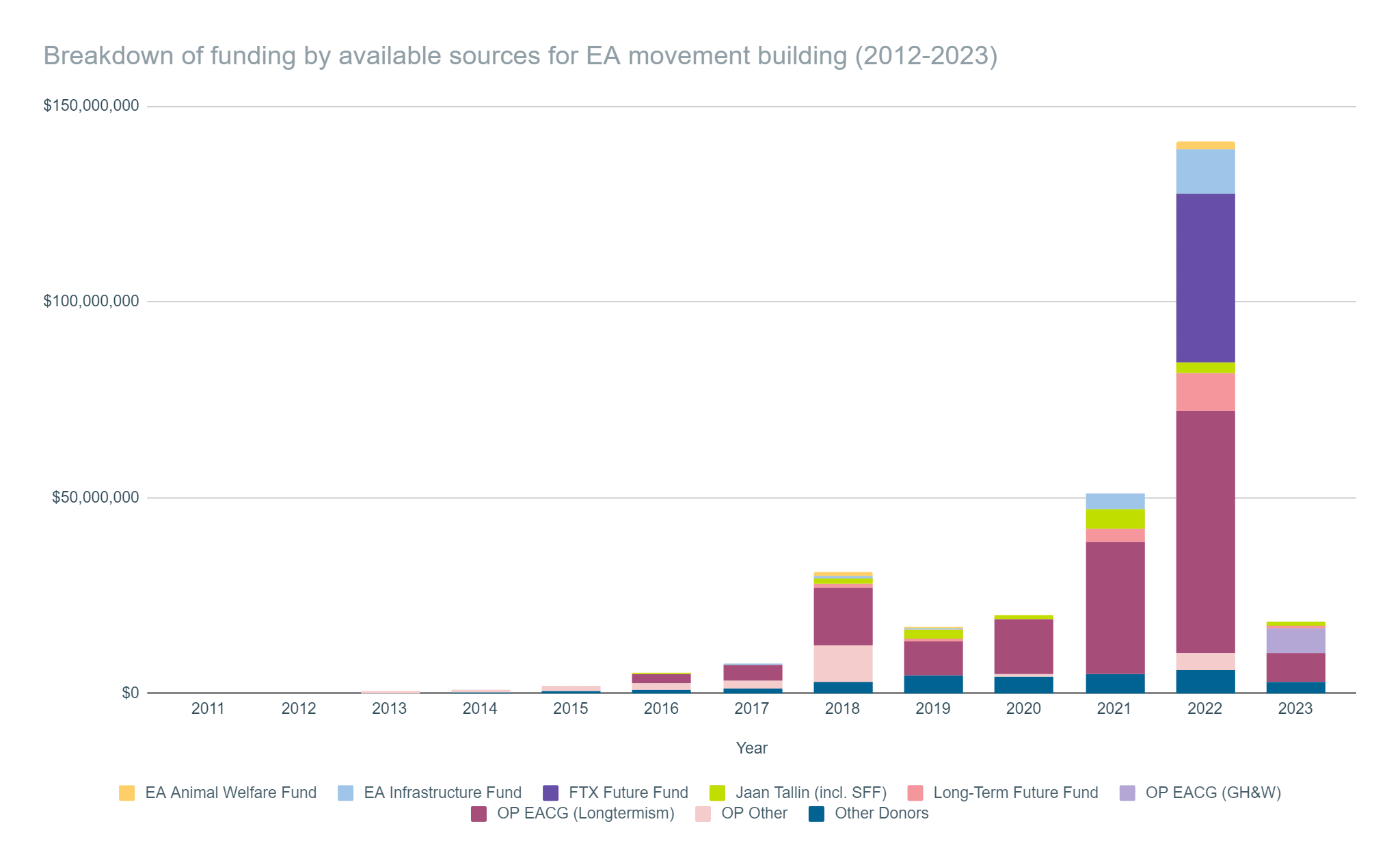
Funders of EA groups (2015-2022)
This text of this section has not been changed since the original publication. The chart has been updated to allow for consistent color-coding.
Let’s look at EA groups (uni, local, & regional/national groups) funding in a bit more detail. In 2022, EA groups funding account for $13.5M of the total $122M in movement building funding, but EA groups have historically played an important role in furthering peoples engagement with the movement.The following graph shows the change in funding to EA groups over time:
In 2017, CEA launched several new regranting initiatives (OP was the primary funder of CEA at this point) - the EAIF & EA Grants in 2017, and the EA Community Building Grants (CBG) program in 2018. EA Grants disbursed $170K to community building efforts in 2017.
CEA launched EA Funds in 2017 with Nick Beckstead (OP) running the LTFF and EAIF funds, mentioning that EAIF would be able to fund CEA and that Nick was a trustee of CEA. They chose grantmakers at OP / GiveWell to manage the funds because they felt that 1) they were good evaluators 2) these grantmakers had the best information available about OP’s grants, and therefore remaining funding gaps. In July 2018, Nick Beckstead stepped down and 5 new fund managers for each fund were appointed in October.
CEA also launched it’s Community Building Grants (CBG) program in 2018 with 1 full-time equivalent (FTE) staff in charge of the program. CEA noted that much historic groups support “provided by CEA, Rethink Charity [previously .impact], EAF [EA Foundation, German EA national group] and others has focused on either seeding local groups or providing a small amount of support to a large number of different groups.” The goal of the CBG was “making some of the most promising local groups even better.” In 2018, they disbursed $623K in funds (~10-15 FTE). There were limited sources of other community building funding at the time. CEA declined to provide the breakdown of funding that went to the CBG program for 2019, 2021 & 2022 so those numbers are imputed at $1M, 2.5M and 2M respectively) (see spreadsheet for rationale). In 2020 they reported spending $1.32M on the CB grants program.
The jump in OP funding in 2022 is explained by CEA discontinuing its focus university groups program in April 2022 and handing it over to Open Philanthropy. I think OP funded more university organizer fellowships ($3M in 2022, vs an estimated ~$500K-2M by CEA in 2021).
The increase in EAIF funding is likely due to the change in scope to include non-target EA groups in 2021, as well as increased funding. Note that in 2022, 83.5% ($8.4M) of EAIF funding and 39% ($2.9M) of LTFF funding came from OP LT (see more on EAIF funding in the appendix).
As far as I’m aware, there are only a few EA groups (at least 4, very likely less than 10) that have received funding from private or individual donors. I would estimate over since 2015, there may have been $150K-500K in such funding granted by other donors.
Thanks to Openbook.fyi for making this research project more efficient and Luke D, Arjun, Amber, Cristina & Dion and several community builders and donors who spoke to me.
Appendix
Breakdown of EA Infrastructure Fund (EAIF) funding sources
After OP, the largest grantmaker in the local / regional EA groups funding space is the EAIF. Here’s what I could find of their funding sources since EAIF first launched:
Data for 2023 is year-to-date as of June 17 2023- I would expect a similar breakdown of direct donations / other institutional donors / OP LT compared to 2022 by the end of 2023. I have requested for a more complete breakdown of funds from EA Funds, but don’t expect it to change the overall trends observed here.
I’ve tracked about $12.4M from 2017-2022 in donations, while total grants EAIF disbursed during this period were $16.5M, so about $4M of donation data is missing. I expect that the difference of $4M will be made up in direct or individual donations which would bring the breakdown of funding to 41% individuals and 59% OP Longtermist.
- Direct donations appear to be made of large donations from a few individual donors. Of the $2.4M of funding between 2017-2021, $1.9M (~79%) came from just 3 donors - Jaan Tallinn ($699K), Jeff Kaufman and Julia Wise ($620K), and another anonymous donor ($600K). I would expect there to be 1-2 other similar donors.
- During 2017-2018, It seems unlikely that OP LT made grants to the EAIF since Nick Beckstead was the grantmaker OP LT and was fund manager of EAIF (OP LT grants are made to CEA and do not disambiguate which programs they funded). I also think it’s fairly unlikely (with lower credence) that they made grants in 2019 and 2020.
- Other institutional donors are recorded in 2022 for $52,000 in donations.
I have requested for a more complete breakdown of funds from EA Funds, but don’t expect it to change the overall trends observed here dramatically.
Breakdown of Funding Table
| Year | Others | OP Other | OP LT | OP GH&W | LTFF | JT +SFF | FTX FF | EAIF | EA AWF | Total |
| 2011 | 35.0K | 35.0K | ||||||||
| 2012 | 26.2K | 64.0K | 90.2K | |||||||
| 2013 | 91.4K | 521.5K | 95.0K | 707.9K | ||||||
| 2014 | 327.8K | 518.0K | 110.3K | 956.1K | ||||||
| 2015 | 680K | 1.2M | 10K | 136.3K | 2.0M | |||||
| 2016 | 939K | 1.8M | 2.4M | 74.3K | 5.2M | |||||
| 2017 | 1.4M | 1.9M | 4.0M | 14.8K | 155.0K | 83.3K | 60K | 7.6M | ||
| 2018 | 2.9M | 9.4M | 14.8M | 927K | 1.5M | 523K | 1.1M | 31.1M | ||
| 2019 | 4.7M | 8.8M | 368K | 2.5M | 415K | 162.5K | 17.0M | |||
| 2020 | 4.2M | 931.0K | 13.8M | 976.2K | 20.0K | 19.9M | ||||
| 2021 | 5.1M | 33.8M | 3.2M | 5.0M | 4.0M | 51.1M | ||||
| 2022 | 5.9M | 4.3M | 62.1M | 9.4M | 2.9M | 43.0M | 11.5M | 2.0M | 141.1M | |
| 2023 | 2.9M | 7.4M | 6.4M | 715.5K | 810K | 135K | 18.3M | |||
| Total | 29.1M | 20.6M | 147M | 6.4M | 14.7M | 14.3M | 43.0M | 16.6M | 3.3M | 295.1M |

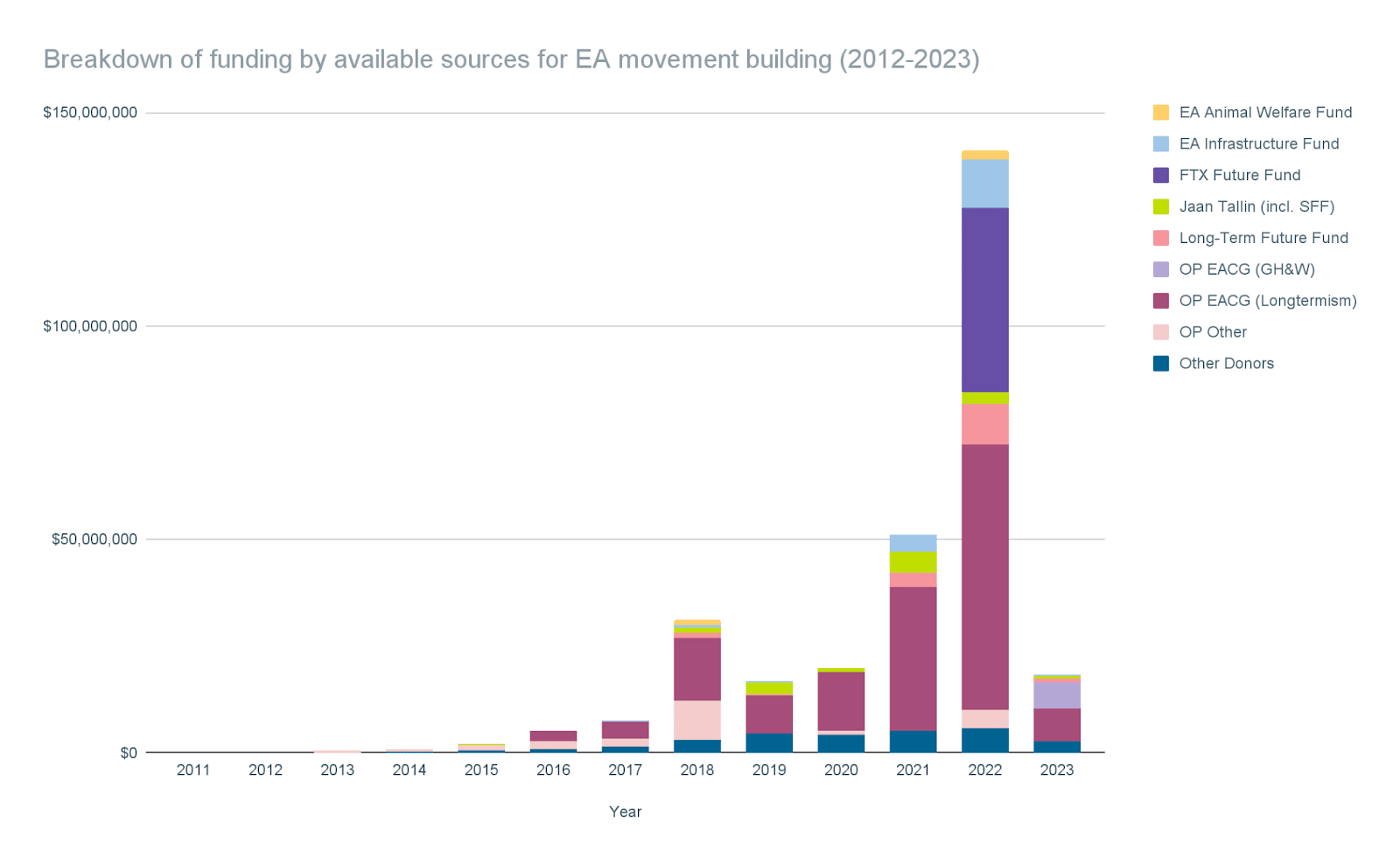
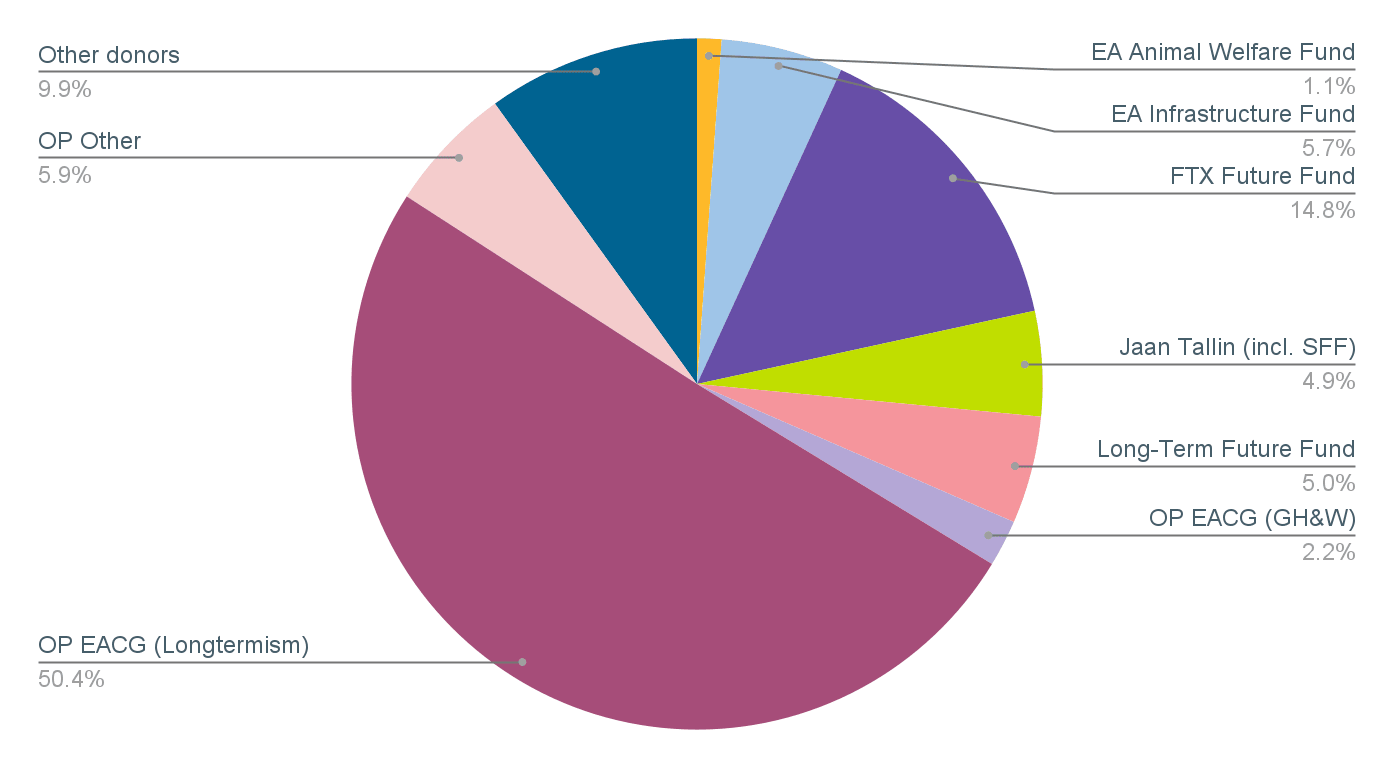
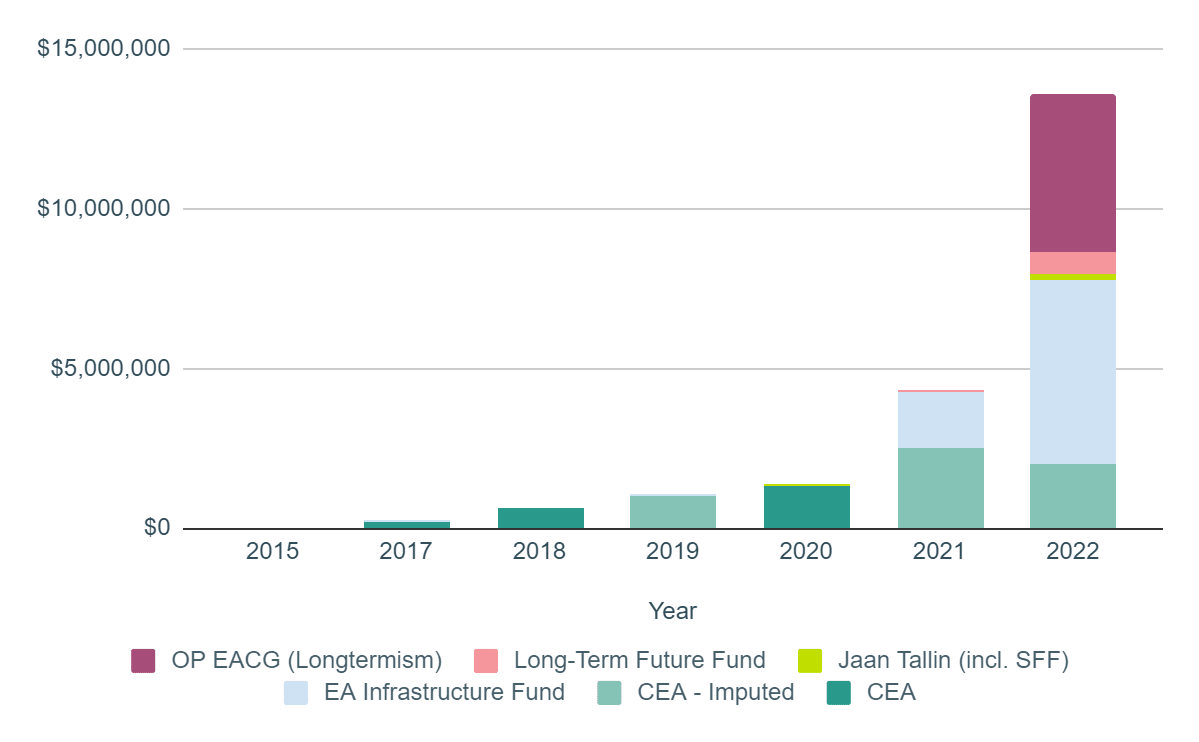
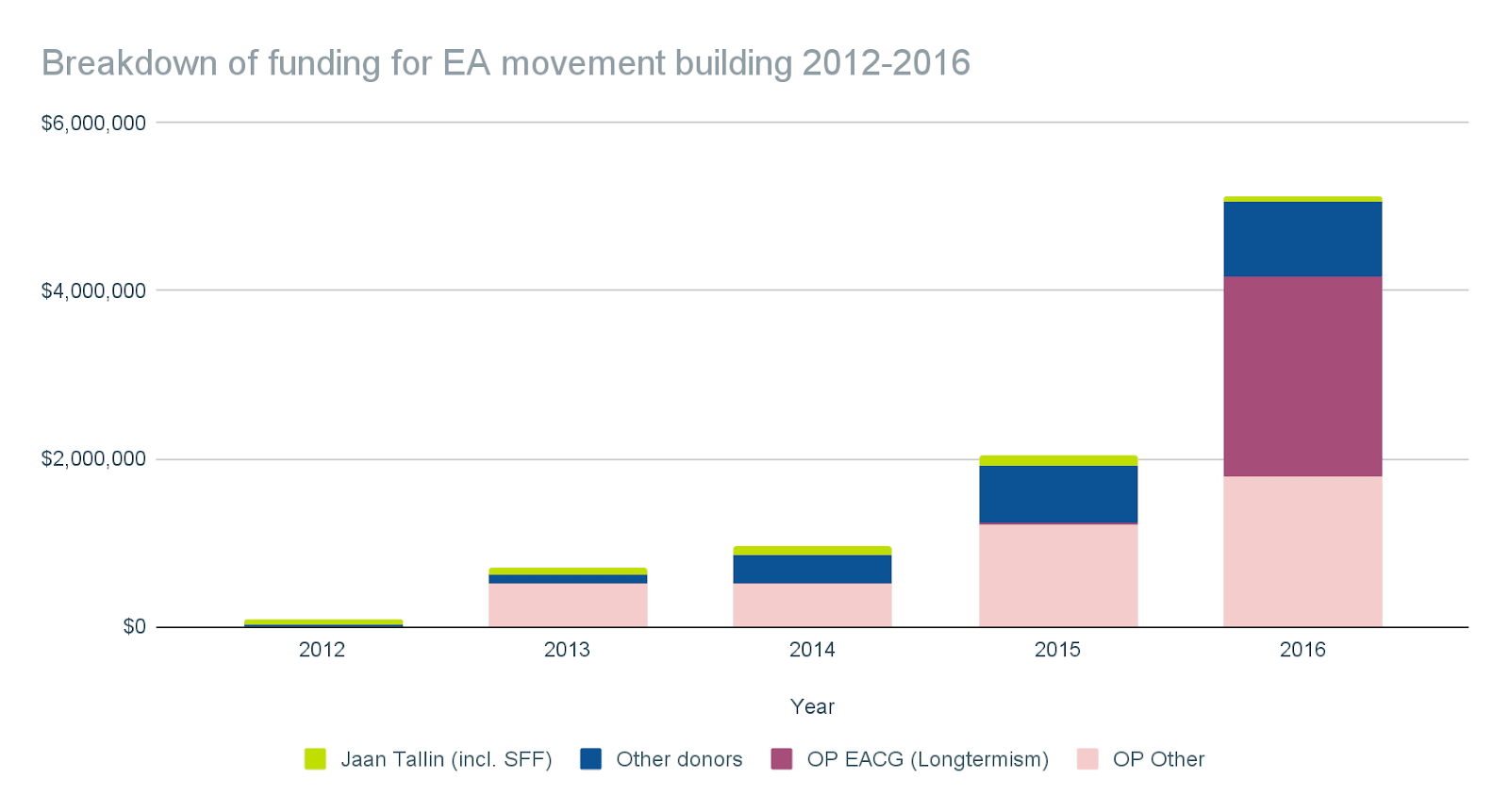

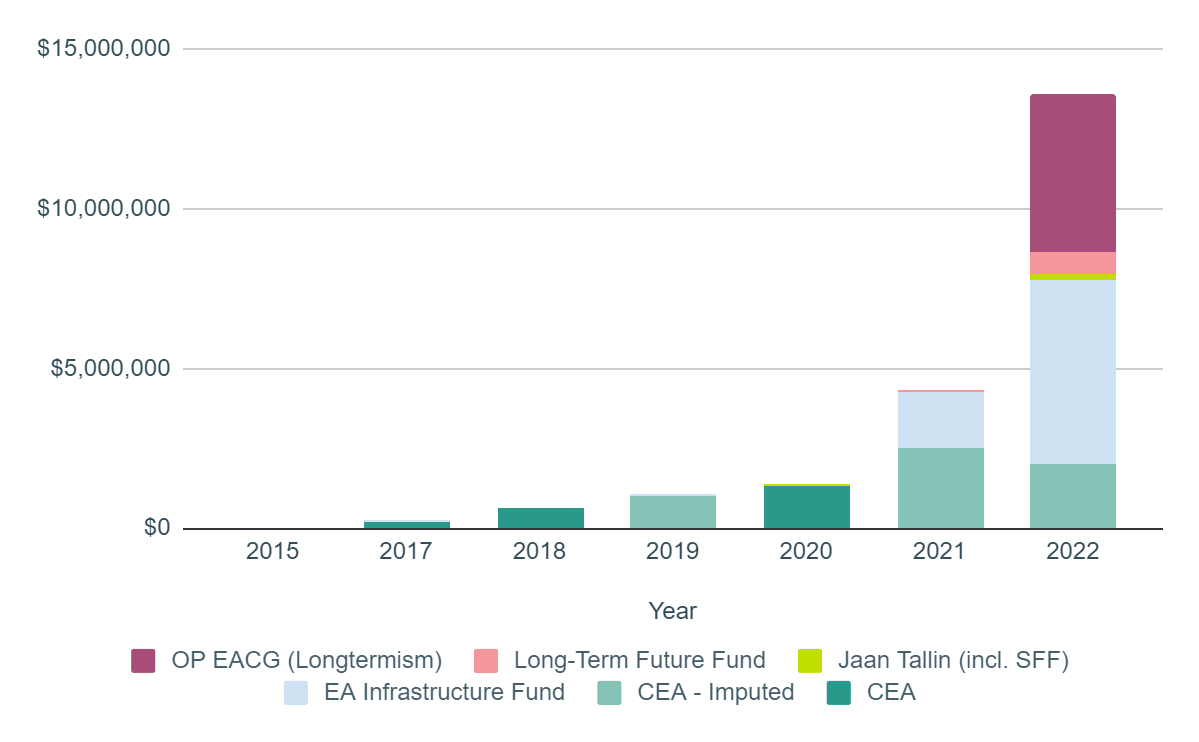

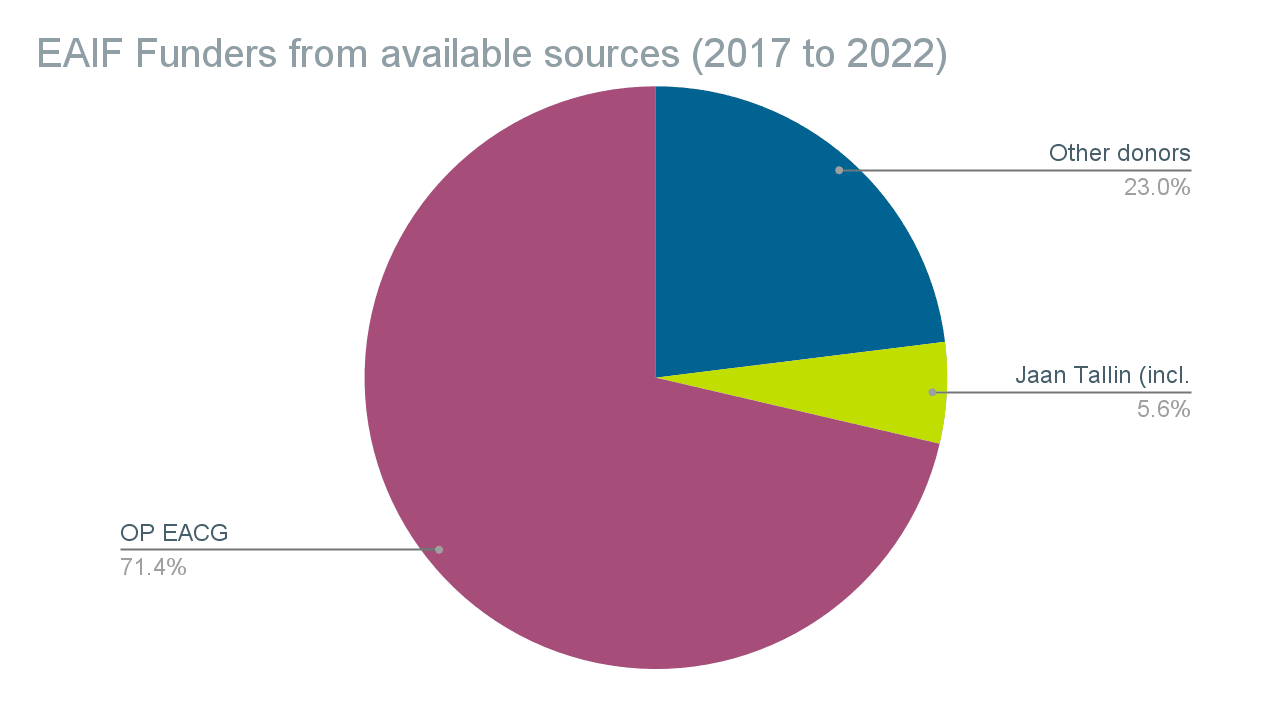
Thanks for compiling this. I have asked for access to the spreadsheet. Amongst others I like to check how much of SFF funding is EA community building vs funding AI and ex-risk research. Also there is a lot of funding from Jane Street donors in addition in Matt Wage just want to make sure they are counted. These are particularly significant in the earlier period.
You may find this spreadsheet useful for that type of information
This looks useful, thanks!
This post has now been updated with new numbers. The summary of changes are detailed in this follow-up post.
Great use of green to mark the errata at top of post, by the way!
Update: I'm reaching out to a few people to add in more individual donor data and will be updating the post once i get those numbers. I expect this would 5-10x the numbers for 2012-2016 for individual donors depending on how I count it, which is a significant increase.
I'll comment here when I've made updates to the charts.
Making the sheet public now! Thanks for checking that Luke.
Feel free to drop comments if you disagree with my categorization - I did it somewhat quickly and probably made a few calls that are debatable.
Regarding individual donors, I have only counted data from folks who were in the OpenBook (I actually don't think Matt is in there, I just listed him in the top section because he's been public about being an earning-to-giver. If you are able to share that data I'd love to add it in!
Thanks Vaidehi. I will take a look when I get a chance and let you know.
So glad this exist, incredible work. EA can aspire to a norm of transparency that is far beyond the standard set by every other movement/industry.
This has been on my mind a lot lately: https://twitter.com/bridget_e_l/status/1659934882301374464?t=C5FCdBv85ujvfJgG7cV1bw&s=19 https://twitter.com/bridget_e_l/status/1665171766434578435?t=jWERYLo7H5dSUiG-L7jWvg&s=19
There seems to be a few directions that this kind of discussion could to go:
What does "ideal funding" look like for the EA ecosystem? What's our model for getting there? I've heard the assumption "we need more billionaires" and I can agree that that's true but I'd love to see a fleshed out model for what that target state looks like. Can we ever have too much money? How would we know?
What are the issues in the current funding landscape and how can they be characterised? I.e. if we think there's too much centralisation, why is that & what are we trading of against?
If you're starting a new organisation, are there any key considerations for how to get funding given what we know about the funding landscape?
By the way, I think this is an unusually high-quality comment, especially considering that it's your first :).
TLDR: Recent funding decline seems unfortunate (for EA Berlin specifically), slightly updated that relying on one major doner is riskier than I thought and that groups should maybe diversify funding sources more.
Thanks for sharing!
Some anecdotal data: From EA Berlin's perspective, the sudden decline in funding earlier this year seemed particularly unfortunate.
I understand why funders were hesitant to fund city groups after the sexual harassment cases that came out in February, but it still seemed unfortunate that CEA withdrew the previously committed funding for EA Berlin, especially as (to my knowledge) none of the sexual harassment cases happened in Berlin or Germany, and both German and international movement builders (CEA staff etc) have said they consider the German EA community particularly friendly and healthy (I think there's still room to improve but overall community health seems good, based on what I've seen).*
I've updated that fully relying on CEA for funding is riskier than I thought before, and diversifying funding should probably be a higher priority for city and national groups.
(I think it's fair to fund groups less when total funding volume decreased and there are strong cases to fund cause/career groups more and broad EA groups less. Still, having the 7th largest city EA group with 100s of engaged members run by volunteers only and not even fund a part-time position seems suboptimal)
*(I was told that CEA withdrew EA Berlin funding mainly because they downprioritised city groups after the sexual harassment cases. There might be more reasons I'm not aware of)
Disclaimer: I ran EA Berlin 2019-21, funded by a CEA grant. The 2023 funding withdrawal did not affect me personally as I stopped doing paid EA meta work last year and have since only supported and advised the group. The top candidates of the "EA Berlin Community Manager" hiring round where unexpectedly left without funding, though, and the position was canceled (for now))
Hi Manuel,
Thank you for sharing your observations and concerns!
I think there are a few points of context that might be helpful. First, the funding for EA Berlin was not retracted. Rather, when EA Germany approached CEA in the fall (before FTX’s collapse) we said that running a hiring round was welcome, but that funding this position would not be guaranteed and that the bar for an additional FTE in Germany would be quite high. This became even more true after FTX's collapse and the funding situation changed. As the EA Berlin hiring proceeded after November, we conveyed that whilst the hiring process could continue, the likelihood of our financial commitment was reduced.
We found ourselves in a situation where available funding was more limited and each new position funded would involve a pretty direct tradeoff with other funding opportunities. Our review of the amount of funding already allocated to EA groups in Germany made us reassess the allocation of marginal dollars. We were persuaded by the possibility that the funding could be more beneficial if allocated to a new country or region, rather than adding an additional FTE in the same country.
The decision ultimately not to fund the EA Berlin position was not related to the recently reported incidents of sexual harassment. We regret any misunderstanding.
Regarding EA Berlin’s status, we value the significant efforts of its many dedicated members and are pleased with the size and accomplishments of this group. However, given the current circumstances, we hope you understand the tough decisions we had to make in order to maximize the impact of available funds.
We agree with your sentiment about the potential benefit for local and national groups to consider diversifying their funding sources. It’s an important strategic consideration that can help ensure the long-term stability and resilience.
I’d be more than happy to discuss in further detail if anything else remains unclear.
Do you think the situation is: Due to CEA not receiving (or being able to spend) previously committed funds themselves, they were forced to withdraw previously committed funding from somewhere, and EA Berlin didn't make the cut?
If not, that seems pretty bad in the absence of EA Berlin doing anything egregiously bad (which it seems they haven't).
From Jesse's comment it sounds like it was neither of these, and CEA hadn't made a commitment?
The EA strategy fortnight is really rocking. Have been amazing posts during the last week and this is no exception!
That 2 out of every 3 community building dollars to date has come from open Phil is a big surprise to me, but I suppose won't be to others.
One point I would be interested in is direct donations from individuals towards community building. Obviously individual donation money will come through other orgs often too so will not be easy to track, but it would be great to see how individual donation money to community building had developed over the years. Seeing the big donations from Jeff Julia and Jan is great but what about the rest post 2016, after earning to give had really got rolling?
Instinctively I would have thought that perhaps a disproportionately high amount of donation money would flow this way, because so many of us have benefited directly from community building activities, especially as students which might make us more inclined to give back as we started earning the big EA bucks, the huge AI safety bucks or the less significant earning to give bucks (j/k)
Anyways is here any easy way to isolate individual donations one this data?
While I expect there are a handful of other large-ish donors not mentioned here (because they'd rather remain anonymous or they've just been missed), I suspect contributions from the vast majority of individual donors just collectively doesn't amount to much compared with the funding sources we see in this post.
Wait, that doesn't sound right? A Google SWE giving 30% is ~$160k/y ($500k pay * 30% + $10k donation match) [EDIT: see comments; $130k/y is better]. If you had 5k of these that would be $800M/y [EDIT: $650M/y]. OpenPhil (especially large and committed for a billionaire) gave $606M in 2022, their most ever.
Maybe 1,000 engineers would be a better estimate? That would give close to what OpenPhil granted in 2018.
what percent of Google SWEs hit $500k?
New grads are hired at L3, and almost everyone makes it to L4, typically within 2-3y. Most of them get to L5, typically 3-5y from then. L5 is a fine place to stay, and getting promoted above that is harder and is no longer most people. I was hired at L3 and got promoted at L6 after about 9y.
Looking at levels.fyi I see average total comp of:
I think this is across the whole US, though, and while I can't get it to show me Bay Area numbers right now, my memory is they are about 30% higher?
But seems like I should have said $400k instead of $500k? Edited my comment above.
I'm curious to compare the growth in funding to the growth in EA group size (uni, local, & regional/national groups). I suspect there was a lot of money put into community development with relatively muted response in growth.
It seems a lot of the community growth dollars went to students to organize on campuses or fly them to EA conferences. The students would have otherwise organized voluntarily and raised necessary funds through fundraisers, like most other university student groups. Many university groups have and continue to thrive without central EA funding support.
My local group got grant funding to pay for an organizer (not me) for roughly a year. We ran a few more events, but I haven't see an appreciably difference in growth or attendance a year later. We have several volunteer organizers that do the job just fine.
I'm skeptical that paid organizers are necessary for any (uni, local, & regional/national) group until the group size reliably reaches 50-100+ at events, which nearly all groups don't meet except in a few of the largest cities (NYC, London).
The community funding, particularly university groups and fellowships, is where a lot of the criticism of profligate spending in EA comes from. I suspect the harm in reputation is comparable or greater than the benefit from the funding. In hindsight it seems that those community growth dollars would have been much better spent on actual EA causes.
Yeah I think it would be fairly easy to look at difference in $ to uni / local / regional groups (I expect pretty confident that 40-75% goes to uni groups, likely closer to the higher end)
Thanks for pulling this together! The methodology is going to slightly overemphasize the degree to which funding increased over time, because increasing funding came at the same time as increased centralization of funding and it's easier to get the numbers for more central funding.
One way to get a lower bound on funding would be to look at how much 80k and GWWC raised for operating expenses in the early years that you haven't already accounted for.
That's right. You have records of non-Tallin donors giving $5k in 2012 and $74k in in 2013, which I think doesn't include the $25k in 2012 and $51k in 2013 from Julia and me?
Yep that's true! I was originally planning to calculate the operating expenses and backfill the chart but it was time consuming, and it was really hard to find data for GWWC / CEA data more generally (I requested CEA for numbers but they declined to provide historical financial figures)
Let me check on your early donations from you and Julia - there may have been an error in my charts!
Update: The 2012 numbers don't include your donations, but the 2013 ones do - I've corrected the 2012 numbers. Thanks for the flag!
Thanks very much for this. I see that OP's longterm pot is really big and I'm wonder if that's all community building, and also what counts as community building.
If you spend money on, say, AI safety research, I guess I'd see that as more like object-level funding than community building. Whereas 'pure' community building is the sort of thing the local groups do: bringing people together to meet, rather than funding specific work for the attendees to do. (If someone funded AMF and their team grew, I'm not sure people would say that's GH and W community building; by analogy, maybe object-level work doesn't count)
Does this seem right? I imagine lots of OPLT's money is object-level stuff rather than pure community building. If so, maybe those should be split apart (and the LT community budget gets quite a bit smaller).
For comparison, if so
Hey Michael! It's a good question.
I have not counted any object level work for any cause (e.g. I included funding for a co-working space, but not the AI safety labs that work out of the space).
The OP LT team has not made any grants that fall into that category, as far as I could see.
However, I did count most (?) longtermist field building projects in my estimates because a lot of them feel like importantly shaping the EA community since most of those people would participate in EA branded events and some would consider themselves post of the community etc. On the flip side, many university groups that are EA branded also end up promoting longtermist careers/causes more than others.
So trying to separate this out is a bit messy.
One thing I didn't include for time constraints is include a couple animal orgs like animal advocacy careers, but I expect the total funding for orgs like that to be <$2M total.
Thanks! Ah, in that case, I'm not sure what that community-building money was spent on - but I guess that's not the question you're asking!
Yeah I considered doing some analysis on the top grantees but ran out of time! Perhaps a future post :)
Suuuuuper useful, thanks very much for pulling all of this together!
Thanks for compiling this data!
I love this.
Do we have any gauge on how accurate the FTX numbers ended up being? More specifically, how much of the donated FTX money ended up either not being distributed, or was ultimately clawed back?
Clawback litigation may take years to resolve.
When I checked a few months ago, there were still a few Madoff clawback matters pending . . . although I expect FTX/EA matters to be simpler than the Madoff litigation.